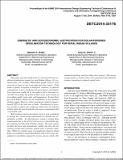| dc.contributor.author | Wright, Natasha Catherine | |
| dc.contributor.author | Winter, Amos G. | |
| dc.date.accessioned | 2017-05-19T13:40:42Z | |
| dc.date.available | 2017-05-19T13:40:42Z | |
| dc.date.issued | 2014-08 | |
| dc.identifier.isbn | 978-0-7918-4631-5 | |
| dc.identifier.uri | http://hdl.handle.net/1721.1/109201 | |
| dc.description.abstract | This paper provides justification for solar-powered electrodialysis desalination systems for rural Indian villages. It is estimated that 11% of India’s 800 million people living in rural areas do not have access to an improved water source. If the source’s quality in regards to biological, chemical, or physical contaminants is also considered, this percentage is even higher. User interviews conducted by the authors and in literature reveal that users judge the quality of their water source based on its aesthetic quality (taste, odor, and temperature). Seventy-three percent of Indian villages rely on groundwater as their primary drinking supply. However, saline groundwater underlies approximately 60% of the land area in India. Desalination is necessary in order to improve the aesthetics of this water (by reducing salinity below the taste threshold) and remove contaminants that cause health risks.
Both technical and socioeconomic factors were considered to identify the critical design requirements for inland water desalination in India. An off-grid power system is among those requirements due to the lack of grid access or intermittent supply, problems faced by half of Indian villages. The same regions in India that have high groundwater salinity also have the advantage of high solar potential, making solar a primary candidate. Within the salinity range of groundwater found in inland India, electrodialysis would substantially reduce the energy consumption to desalinate compared to reverse osmosis, which is the standard technology used for village-level systems. This energy savings leads to a smaller solar array required for electrodialysis systems, translating to reduced capital costs. | en_US |
| dc.description.sponsorship | Massachusetts Institute of Technology. Tata Center for Technology and Design | en_US |
| dc.description.sponsorship | Massachusetts Institute of Technology. Undergraduate Research Opportunities Program | en_US |
| dc.language.iso | en_US | |
| dc.publisher | American Society of Mechanical Engineers (ASME) | en_US |
| dc.relation.isversionof | http://dx.doi.org/10.1115/DETC2014-35176 | en_US |
| dc.rights | Article is made available in accordance with the publisher's policy and may be subject to US copyright law. Please refer to the publisher's site for terms of use. | en_US |
| dc.source | American Society of Mechanical Engineers (ASME) | en_US |
| dc.title | Energetic and Socioeconomic Justification for Solar-Powered Desalination Technology for Rural Indian Villages | en_US |
| dc.type | Article | en_US |
| dc.identifier.citation | Wright, Natasha C., and Amos G. Winter. “Energetic and Socioeconomic Justification for Solar-Powered Desalination Technology for Rural Indian Villages.” ASME 2014 International Design Engineering Technical Conferences and Computers and Information in Engineering Conference, 17-20 August, Buffalo, New York, USA, 2014, ASME. © 2014 by ASME | en_US |
| dc.contributor.department | Massachusetts Institute of Technology. Department of Mechanical Engineering | en_US |
| dc.contributor.mitauthor | Wright, Natasha Catherine | |
| dc.contributor.mitauthor | Winter, Amos G. | |
| dc.relation.journal | Proceedings of the ASME 2014 International Design Engineering Technical Conferences & Computers and Information in Engineering Conference IDETC/CIE 2014 | en_US |
| dc.eprint.version | Final published version | en_US |
| dc.type.uri | http://purl.org/eprint/type/ConferencePaper | en_US |
| eprint.status | http://purl.org/eprint/status/NonPeerReviewed | en_US |
| dspace.orderedauthors | Wright, Natasha C.; Winter, Amos G. | en_US |
| dspace.embargo.terms | N | en_US |
| dc.identifier.orcid | https://orcid.org/0000-0003-3687-188X | |
| dc.identifier.orcid | https://orcid.org/0000-0002-4151-0889 | |
| mit.license | PUBLISHER_POLICY | en_US |
| mit.metadata.status | Complete | |
